Eur. Phys. J. C (2020) 80:326
https://doi.org/10.1140/epjc/s10052-020-7881-2
Letter
Gravitational waves with orbital angular momentum
Pratyusava Baral1,a, Anarya Ray2,b, Ratna Koley1,c
1 Department of Physics, Presidency University, Kolkata 700073, India
2 Department of Physics, University of Winsconsin, Milwaukee 53211, USA
3 School of Physical Sciences, Indian Association for the Cultivation of Science, Kolkata 700032, India
, Parthasarathi Majumdar3,d
Received: 4 October 2019 / Accepted: 27 March 2020
© The Author(s) 2020
Abstract Compact orbiting binaries like the black hole
binary system observed in GW150914 carry large amount
of orbital angular momentum. The post-ringdown compact
object formed after merger of such a binary configuration
has only spin angular momentum, and this results in a large
orbital angular momentum excess. One significant possibility
is that the gravitational waves generated by the system carry
away this excess orbital angular momentum. An estimate of
this excess is made. Arguing that plane gravitational waves
cannot possibly carry any orbital angular momentum, a case
is made in this paper for gravitational wave beams carrying
orbital angular momentum, akin to optical beams. Restrict-
ing to certain specific beam-configurations, we predict that
such beams may produce a new type of strain, in addition to
the longitudinal strains measured at aLIGO for GW150914
and GW170817. Current constraints on post-ringdown spins,
derived within the plane-wave approximation of gravitational
waves, therefore stand to improve. The minimal modification
that might be needed on a laser-interferometer detector (like
aLIGO or VIRGO) to detect such additional strains is also
briefly discussed.
1 Introduction
Gravitational waves (GWs) detected by the Advanced Laser
Interferometer Gravitational Wave Observatory (aLIGO) [1–
3] have established the existence of inspiralling compact
object binaries. Within General Relativity (GR), such sys-
tems radiate gravitational waves, carrying energy and angular
momenta [4,5], while spiraling into each other. The amount
of angular momentum carried, as viewed by an observer at
infinity (assuming the space-time to be asymptotically flat)
a e-mail: baralpratyusava@gmail.com
b e-mail: ronanarya9988@gmail.com
c e-mail: ratna.physics@presiuniv.ac.in (corresponding author)
d e-mail: bhpartha@gmail.com
can be estimated by the difference in angular momentum of
the initial and final stages of a merger. GW150914 confirmed
the merger of two black holes separated by a radius of 210 km
and of masses around 36 M and 29 M, forming a resul-
tant Kerr black hole of mass ∼ 62 M and a spin parameter
of ∼ 0.67 [1]. We estimate the rate of loss of orbital angular
momentum by the coalescing binary, assuming the objects to
be slowly moving, such that the quadrupole approximation
to gravitational wave generation still holds. In this approxi-
mation, the rate of loss of orbital angular momentum can be
given as
d�r 2˙habx j ∂khab
Qka
...
d Li
dt
= c3
32π G
= 2G
15c5
2G
15c5
�i jk
�i jk ¨Q ja
(μr 2)2ω5
(1)
Inserting typical values for the masses (∼ 30 M) and the
size of the compact binary (∼ 200 km), with the rotational
angular frequency of about 10 Hz, the rate of loss of orbital
angular momentum from the system is about 1034 Joules—
which is quite large. An actual estimate of orbital angular
momentum radiated closer to merger would include higher
order modes and thus increase the number. From such an esti-
mate, the motivations for a serious analysis towards the possi-
bility of detection of such a large orbital angular momentum,
carried by the gravitational waves, in current and forthcom-
ing laser interferometer experiments are very strong.
Measuring spacetime fluctuations as a function of time
only, aLIGO has successfully constrained source parame-
ters from which one can calculate radiated angular momen-
tum [9–11]. However a subtle issue arises if we want direct
measurement of angular momentum at some future detec-
tor. As we show in the sequel, monochromatic plane waves
with spatially constant polarizations, used predominantly in
detection analysis, cannot carry orbital angular momentum.
0123456789().: V,-vol
123
�
326 Page 2 of 7
Eur. Phys. J. C (2020) 80:326
Specifically, gravitational waves cannot reach the detector as
monochromatic plane waves due to angular momentum con-
servation. We stress that by the term ‘plane wave’ we mean, a
monochromatic wave solution of the linearized, source-free
Einstein equation, not only whose constant phase surfaces
are planes in spacetime, but also whose polarizations are spa-
tially constant, as the wave propagates. Taking a clue from
well established results in optics [12–16], we propose gravi-
tational radiation with some phase structure or gravitational
wave beams as a basis for expansion of the source wave-
form for detection analysis. The phase structure would enable
us to measure orbital angular momentum directly. Recently,
radiation from a spiralling charged particle [17,18] carrying
orbital angular momentum in the context of classical electro-
dynamics, has been shown to possess a similar phase struc-
ture.
There exist other motivational aspects of directly measur-
ing angular momentum from gravitational waves. A direct
measurement of orbital angular momentum would provide
us with an estimate of its rate of loss from the inspiralling
binary. This, in turn, might allow us to impose additional
constraints on the parameters over and above those obtained
by cross-correlation with various templates. This would fur-
ther enable us to settle many controversies relating to various
mergers [20] like GW170817 [3] (NS–NS merger) which are
expected to be routine in the near future. Using this, we may
also expect to put constraints on the exotic alternative com-
pact objects like fuzz balls [21], gravastars [22,23], worm-
holes [24], boson stars [25] and so on, and hence be able
to ascertain better the actual composition of the coalescing
binary. Comparing how well the estimated angular momen-
tum loss of the system compares to the angular momen-
tum carried by gravitational waves as detected by a faraway
observer, additional restrictions on the validity of GR in the
linearized regime may perhaps be ascertained. Lastly, the
third-generation run of the aLIGO and VIRGO is expected to
detect certain gravitational lensing events [19]. An additional
probe of angular momentum is expected to give us additional
knowledge of the medium through which it passes. This may
vastly improve our understanding of interactions of gravita-
tional waves with matter as it passes through astrophysical
objects such as stars or galactic clusters. However for the
time-being, we focus on a direct independent study of orbital
angular momentum carried by gravitational waves.
In this paper we examine the analytic structure of grav-
itational waves in the linearized regime, starting from the
gauge fixed linearized vacuum Einstein equation. We further
demand solutions that carry orbital angular momentum (We
prove that plane waves do not carry orbital angular momen-
tum in the next section). This naturally enables us to go
beyond plane waves and discuss gravitational wave beams.
However our solutions are well within the regime of Gen-
eral Relativity and does not take any modified gravity effect
123
into account. We show en passant that plane waves cannot
carry orbital angular momentum, implying that recourse to
gravitational wave beams is imperative. We choose a par-
ticular set of linearly independent beams which form a basis
for gravitational waves with orbital angular momentum. Any
gravitational radiation generated by sources within general
relativity can be expanded in this beam basis. A brief dis-
cussion is presented on the effects these beams would have
on spacetime. We also give a schematic outline, how these
beams carrying orbital angular momentum may be detected
and the contribution of the beam to the overall signal mea-
sured in a generic Laser-interferometer gravitational wave
detector.
2 Gravitational wave beams
We employ here the linearized tetrad formalism [27] for dis-
cussing gravitational waves, for two reasons: the ease to dis-
cuss fermionic interactions in astrophysically relevant quan-
tum field theoretic analysis, and to understand better the tran-
sition from local Lorentz invariance to global Lorentz sym-
metry under linearization—a phenomenon which remains
slightly obscure within the metric formalism. However, the
prescription to change to metric computations is included,
for the ease of the readers.
For the purpose of linearization, the spacetime tetrad com-
a are decomposed as eμa = eμa + εμa, where
ponents eμ
eμa is the background Minkowski spacetime tetrad and
as, ea
εμa is the linear fluctuation. Linearized gravity in the har-
monic gauge using this perturbed tetrad can be expressed
ν2εaμ = 0 where Greek indices specify
spacetime labels and early Latin indices are tangent space
labels. The late Latin indices are reserved for three dimen-
sional space. Therefore, the metric and fluctuations turns out
to be
μ2εaν +ea
ημν = ηabea
μeb
μεaν +ea
hμν =ea
ν
ν εaμ + O(ε2)
(2)
(3)
Equation (3) explicitly states how to transform from the met-
ric fluctuations to the tetrad fluctuations and vice-versa.
The gauge fixed linearized tetrad equation admits a wave
like solution given by,
εaμ = ϑaμ(x σ ) exp(ikλx λ) + ϑ∗
aμ(x σ ) exp(−ikλx λ)
(4)
∗
) representing complex conjugation. This
with the asterisk (
solution imposed on linearized tetrad equation gives,
(∂ ν ∂ν + 2ikν ∂ ν ) ϑaμ(x) = 0.
(5)
�
Eur. Phys. J. C (2020) 80:326
Page 3 of 7 326
The Lagrangian density and the energy-momentum tensor
for linearized gravity [28] are
L = − c4
32π G
T μν = c4
16π G
(∂ μεaσ ∂μεaσ +ea
(∂ μεaσ ∂ ν εaσ +ea
σebρ ∂ μεaρ ∂μεb
σebρ ∂ μεaρ ∂ ν εb
σ )
σ )
(6)
(7)
Since we are dealing with small fluctuations around a
Minkowski spacetime tetrad in the linearized region, the sys-
tem is globally Lorentz-symmetric. The conserved Noether
charge density corresponding to this symmetry can be
expressed as,
Mρσ = ˙εaμ[x[ρ|(∂|σ]εaμ +ea
νebμ∂|σ]εb
ν )]
(8)
8π G
c2
where, over dot represents time derivative, and the square
brackets denote anti-symmetry. Integrating this charge den-
sity over all space gives the infinitesimal Lorentz generators.
If ϑaμ is not a function of the spatial coordinates (xi )
(xi k j −
on integration the first term reduces to terms like
x j ki )d3x; with the integration measure being clearly rota-
tionally invariant, the first term vanishes by spatial rotational
invariance ! This implies that a spatially constant polariza-
tion, like for plane waves in our connotation [which definitely
satisfy Eq. (5)], cannot carry orbital angular momentum. It
follows that for gravitational waves to carry orbital angular
momentum, their polarization tensors must themselves be
tensor fields. One way to enable polarization fields in grav-
itational waves is through gravitational wave beams, akin
to optical beams. Plane waves definitely carry spin angu-
lar momentum. But the spin angular momentum density
is miniscule, and definitely cannot account for all angular
momentum radiated. Moreover the spin part is a property of
the radiation and can never be zero for a rank two tensor
field. The orbital angular momentum is dependent on orien-
tation of objects and fields and thus somewhat arbitrary. Thus
there is no reason to expect that orbital angular momentum
of source is getting converted to spin angular momentum of
the wave. Thus we are looking for the most general solution
of linearized vacuum Einstein field equations.
2.1 Laguerre–Gaussian (LG) beams
Let z direction be the direction of propagation of the grav-
itational wave beam. Since any conceivable detector has to
be placed far away from the sources, we can safely assume
the beam to be paraxial (kz ≈ k) [14,15]. So Eq. 5 can be
expressed as
(∇T
where ∇T
2 is a two dimensional Laplace operator in the
plane perpendicular to z. The paraxial approximation also
guarantees that the change in polarization tensor in the
2 + ∂ z∂z − ∂t ∂t + 2ikz∂ z − 2ikt ∂t ) ϑaμ(x) = 0
(9)
r 2
T = 1
r
∂2ϑ aμ
kz
direction of propagation is negligible in comparison to the
. So Eq. (9) reduces to,
wave vector
(∇T
2+ 2ikz∂ z) ϑaμ(x) = 0. We choose the transverse plane
∂r + ∂r
to be spanned by (r, φ) then ∇2
2 + 1
∂ϑ aμ
∂z2
∂φ
2.
∂z
For simplicity, we choose to work with one particular com-
ponent of ϑaμ and for the time being we drop the spacetime
and tangent space indices.
A solution of the form
√
−ikr 2z
2r
2(z2 + z2
w(z)
imφ − i (2 p + |m| + 1) tan
−r 2
ϑmp(r, φ, z) = Amp
w(z)
× exp
× exp
|m|
p
2r 2
w2(z)
−1 z
z R
|m|
exp
(10)
L
R
)
w2(z)
λ
2π
z
z R
2
λ . L
where
and k ≈ kz = 2π
satisfies Eq. (9) in its paraxial form [15] with m, p taking
integer values referring to various modes. The radius of the
1 +
beam w(z) is given by w(z) = w(0)
|m|
z R = π w(0)
p (x) is the associated
Laguerre polynomial while Amp is a normalization constant.
By definition of Laguerre polynomials, p has to be an integer.
The single valuedness of the field under a rotation of π radian
forces the azimuthally dependent phase factor to be quantized
with m taking only integral values. The Laguerre–Gaussian
modes are orthonormal in both labels m & p such that
rdr ϑmp(r, φ, z)[ϑqr (r, φ, z)]∗ = δmq δ pr .
∞
0
This guarantees that the LG modes form a complete orthonor-
mal family which can be used as a basis for a beam with
an arbitrary polarization distribution. These beams exhibit
a symmetry manifest in the use of cylindrical coordinates.
Any other choice of a complete set of beams a different sym-
metry (like, e.g., the Bessel beam) is equally valid; these
beams can of course be expressed as a linear combination of
LG modes. Since our solutions form a basis, any waveform
including plane waves or spherical waves can be expanded
in our basis.
dφ
0
The orbital angular momentum density can be expressed
in a simple form which follows directly from Eq. (8),
L =
d3x
− l
ω
|ϑmp|2ˆr + r
c
z
r
+ l
ω
|ϑmp|2ˆz
− 1
|ϑmp|2 ˆφ
z2
z2+z2
R
(11)
Such solutions also exist in the case of electromagnetic
waves and have been extensively studied in Refs. [12–
16]. Bialynicki-Birula et al. [29] have also discussed GW
beams using an electromagnetic-gravitational correspon-
dence within a spinoral formalism. In this work we take an
123
�
326 Page 4 of 7
Eur. Phys. J. C (2020) 80:326
approach that appears to be more convenient for phenomeno-
logical applications.
Integrating the angular momentum density (11) over all
space, we get the total angular momentum. As stated earlier
our analysis is only valid in the weak field regime. So, the
integration domain must be restricted to that regime. Here we
should mention the caveat that unlike in laser optics, w(0)
has no significance and is just a free parameter of the chosen
basis.
3 Effect of a passing gravitational wave beam on
spacetime: possible detection
Fig. 1 A ring of masses in presence and absence of GWs
εa
εa
εb
x
x + eb
x
y + eb
y
x and h× = ea
We first describe the effect on spacetime in the plane per-
pendicular to the direction of propagation. Let this trans-
verse plane be spanned by coordinates x, y. It is well known
that in standard TT gauge all perturbation except h+ =
ea
εb
x can be gauged
x
away to 0. To start with let us consider a gravitational wave
beam consisting of only the component h+ . The correspond-
ing tetrad fluctuation εaμ=x contains an infinite number of
various LG modes. The proper distance between four test
particles localized at A(0, 0), B(L , 0), C(L , L) and D(0, L)
would change due to the passing gravitational wave. Firstly
let us consider motion along or parallel to x-axis. Therefore,
dt 2 = dy2 = dz2 = 0.
ds2 = (1 + 2ea
ea
⇒ �l
⇒ �l =
(C + g(y))dx
εax dx f (y)
εax )dx 2
l
l
0
0
(12)
(13)
x
x
l
= Cl +
g(y)dx
0
(14)
f (y) and g(y) are functions of y differing with a
where,
constant value of C.
The decomposition of the integral into two parts, one
involving a constant C which is the dominant plane wave con-
tribution; the sub-dominant contribution is due to the beam
structure. The first term gives normal longitudinal strain as
expected by plane waves and the second is a non-longitudinal
term. The second term which is essentially due to deviation
from plane waves carry all information about radiated angu-
lar momentum giving rise to various new non-trivial effects.
If a gravitational wave of constant polarization passes over
a circular ring of particles (shown by bold green dots), they
would change to an elliptical ring (shown by red dots) as
shown in Fig. 1.
The presence of a LG mode would deviate the masses
from their expected places (shown by blue crosses) due to the
second term in Eq. (14). The deviation from an ellipse for the
123
Fig. 2 Absolute deviation from an ellipse
lowest mode is plotted in Fig. 2. The symmetry in the figure
is precisely due to the symmetry in x and y coordinates for
m = 0 mode. Since each h+ and h× will contain an infinite
number of LG modes, both these polarizations will contain
a smear of infinitely many polarization states.
3.1 Effect of gravitational wave beams on
laser-interferometer detectors
Observational evidence for gravitational wave beams neces-
sitates direct measurement of the polarization as a function
of space and time. Unfortunately it is not easy to achieve this
for extant laser interferometer set-ups. The important aspect
�
Eur. Phys. J. C (2020) 80:326
Page 5 of 7 326
is that the change in the length of an interferometer arm is no
longer a simple linear function of its original length, if the
interferometer is exposed to a gravitational wave beam. This
departure from linearity can be exploited to infer informa-
tion about possible orbital angular momentum of the incident
gravitational wave.
We shall now attempt to assess the effect of gravitational
wave beams with the stated polarization profile on laser inter-
ferometer detectors. Let the plane of the detector be spanned
by x, y coordinates and the direction of propagation make
an arbitrary angle with the z-axis. This detector will mea-
sure the intensity of the component of the incoming beam of
gravitational waves along the z direction.
εb
εb
x
εa
x
x+eb
x +eb
y+eb
the x y plane, ds2 = c2dt 2− dx 2{1+ (ea
For laser beams travelling along the arms of a detector in
x )ηab}−
dy2{1−(ea
x )ηab}−dxdy(ea
x )ηab = 0.
x
εb
Now for the x-arm (length = L), y = 0 = dy, and for the
y-arm (length = L), x = 0 = dx. Thus,
εax|y=0 ≈ dx(1 +ea
cdtx = dx
1 + 2ea
εax|y=0)
(15)
εa
x
εa
y
x
x
x
c
Using Eq. (4) and putting t = x
c or t = y
c for the for-
and L+y
ward journey and t = L+x
ney, [30] we get: τx = 2L +
for the return jour-
ea
(ϑax (x, 0, z)eik(z−x) +
−ik(z−x))dx+
ea
(ϑax (x, 0, z)eik(z−(L+x))+
ϑ∗
−ik(z−(L+x)))dx.
ϑ∗
(x, 0, z)e
ax
(x, 0, z)e
ax
Similar equations hold for the y-direction. Now we can
calculate the phase difference between the x and y arm light
rays:
L
0
L
0
c
x
x
δφ (L) = 2π(τx − τy)
λlight
= f (L) ≈ α + β L + γ L2
(16)
where α,β and γ are constants. For plane waves γ = 0.
δφ (4km) depends on L when m =
Figure 3 shows how δφ (L)
p = 0. It clearly deviates from the linear nature shown by
the blue dots. The value of 4 km is chosen for our numerical
analysis. It has no special significance and any other choice
is equally valid. The ratio does not depend on the value of
w(0) (in the range 102 − 108 m) in this case. For m = 1, the
nature of the plot remains similar to that of Fig. 3, although
it is now sensitive to w(0). The strains definitely depend on
the value of w(0) (as well as L) as shown in Fig. 3. As is
clear from the graph, typical strain values predicted for a
binary black hole merger source as reported for GW150914,
is about ∼ 10
−21 which is very much detectable by aLIGO
type detectors. If m = 1 we have a (1/z) factor suppression
of the gravitational wave signal, leading to additional strain
(due to orbital angular momentum carried by gravitational
waves) values that are far smaller than current sensitivities.
Fig. 3 The variation of
been shown for m = 0, p = 0
δφ (L)
δφ (4km) with interferometer arm length has
3.2 Detection scheme
Thus, it can be seen that the unlike the case for a plane wave
where δφ is directly proportional to the wave amplitude and
the arm length L, if the incident wave carries angular momen-
tum and hence a beam of polarization, the phase difference
will vary as a nonlinear and complicated function of arm-
length.
If it is possible to vary the arm length, we can measure δφ
for different values of L, and by comparing the data obtained
with the functional dependence shown in Fig. 3 and using
sophisticated statistical techniques and proper source mod-
eling, one may directly measure the total angular momentum
carried by gravitational waves.
4 Conclusions
As electromagnetic beams carry orbital angular momentum,
we have shown in this paper that there is sufficient reason to
expect the same for gravitational waves. However, the main
point of difference is that unlike lasers we cannot make any
form of ‘gaser’ (a gravitational laser!!) and thus are depen-
dent on nature to produce gravitational wave beams that carry
orbital angular momentum. Luckily it turns out that the sim-
plest detectable gravitational wave emitting system, should
radiate angular momentum. Unlike man-made lasers which
usually have one particular mode, a gravitational wave will
be a collection of various modes. Although any particular
mode of a specific class of beams, can be expressed as a linear
superposition of various modes of another class of beams, we
have chosen LG modes as they are perhaps the simplest and
most elegant solution, suffering no problem of divergence at
asymptotic regions.
123
�
326 Page 6 of 7
Eur. Phys. J. C (2020) 80:326
In this paper, in addition to showing the necessity of con-
sidering gravitational wave beams in place of plane waves
in order to explain the orbital angular momentum emitted
via gravitational waves, by the merger of inspiralling com-
pact binaries, we have presented an account of the effects
these gravitational wave beams will have on spacetime in
general and on laser interferometer detectors. Further, per-
haps for the first time, we have proposed a schematic way
of measuring the phase structure of gravitational radiation,
by incorporating minimal changes in extant interferometers.
Since the orbital angular momentum of gravitational waves
can be directly calculated from these amplitudes, we have
thus, again for the first time, proposed a schematic method
of direct measurement of angular momentum carried by grav-
itational waves.
We are primarily interested in the lowest order mode,
because the first higher mode for GW150914 like sources
will have non-unique values of strains dependent on the
normalization factor w(0) and primarily because we have
a 1/zm-suppression. This might make the interference signal
too weak to detect. Having said that though, the expressions
are dependent on various non-linear parameters and a par-
ticular set of w(0); tweaking the frequency and distance it
may be possible to produce such additional strains for higher
modes, which are more realistic.
The idea of gravitational wave beams is at its infancy and
thus lot of work remains to be done. From the values of the
plus and cross polarizations at asymptotic regions obtained
from various numerical simulations one might try to estimate
various beam parameters. Since the beams form a complete
basis, any wave form predicted by numerical relativity can
always be expanded in terms of the beams by computing
the overlap integrals and the corresponding beam parameters
measured via the scheme discussed in this paper. This would
enable us to understand if data from a fixed length detector
is sufficient to determine the beam parameters uniquely with
a little degeneracy. Although this work is yet to be done, our
intuition suggests that the deviation from plane waves will
not become apparent due to their smallness until we have
some way to vary the length of detectors. However a more
rigorous calculation is left to be done before making any
concrete statement.
Moreover the solution presented here involves the paraxial
approximation. It is possible to get exact solutions of the
vacuum linearized Einstein’s equations beyond the paraxial
approximation, which still carry orbital angular momentum
and form a complete basis. This is currently under study.
Acknowledgements The authors would like to thank Soumendra
Kishore Roy and Sk. Sajid of Presidency University, Kolkata for valu-
able discussions and inputs. R. Koley acknowledges WBDHESTBT
research fund. PB and AR would like to thank Bala Iyer of ICTS, K. G.
Arun and J. Haque of CMI,India and A. Gupta of Pennsylvania State
University for discussions in the IAGRG meeting 2018. PB is grateful
123
to Luc Blanchet for a discussion at the 2019 ICTS Summer School on
Gravitational Waves regarding total orbital angular momentum radiated
away through gravitational waves.
Data Availability Statement This manuscript has no associated data
or the data will not be deposited. [Authors’ comment: Since we have
a complete basis any waveform (including plane waveform) can be
described using our solution. So in principle using the present LIGO-
Virgo detectors we can estimate our beam parameters. But the issue
that needs to be checked is if the parameter space is degenerate or not.
Moreover increasing number of parameters will naturally improve the
likelihood function, and thus one requires detailed statistical analysis
of the parameters before blindly estimating it. We plan to work on this
in the near future and hope to come up with a more concrete statement
on the detectability of beam parameters from fixed length detectors.]
Open Access This article is licensed under a Creative Commons Attri-
bution 4.0 International License, which permits use, sharing, adaptation,
distribution and reproduction in any medium or format, as long as you
give appropriate credit to the original author(s) and the source, pro-
vide a link to the Creative Commons licence, and indicate if changes
were made. The images or other third party material in this article
are included in the article’s Creative Commons licence, unless indi-
cated otherwise in a credit line to the material. If material is not
included in the article’s Creative Commons licence and your intended
use is not permitted by statutory regulation or exceeds the permit-
ted use, you will need to obtain permission directly from the copy-
right holder. To view a copy of this licence, visit http://creativecomm
ons.org/licenses/by/4.0/.
Funded by SCOAP3.
References
1. B.P. Abbott et al., Phys. Rev. Lett. 116, 241102 (2016).
arXiv:1610.02182 [gr-qc]
2. B.P. Abbott et al., Phys. Rev. Lett. 118, 221101 (2017).
arXiv:1706.01812 [gr-qc]
3. B.P. Abbott et al., Phys. Rev. Lett. 119, 161101 (2017).
arXiv:1710.05832 [gr-qc]
4. A. Einstein, Sitzungsber. K. Preuss. Akad. Wiss. 1, 688 (1916)
5. A. Einstein, Sitzungsber. K. Preuss. Akad. Wiss 1, 154 (1918)
6. S. Stevenson et al., Nat Commun. (2017). https://doi.org/10.1038/
ncomms14906 arXiv:1704.01352 [astro-ph.HE]
7. I. Mandel, A. Farmer. arXiv:1806.05820 [astro-ph.HE]
8. I. Bialynicki-Birula, S. Charzy´nski, Phys. Rev. Lett. 121, 171101
(2018). arXiv:1810.02219 [gr-qc]
9. K. Thorne, Rev. Mod. Phys. 52, 299 (1980)
10. T.W. Baumgarte, S.L. Shapiro, Numerical Relativity: Solving Ein-
stein’s Equations on the Computer, 1st edn. (Cambridge University
Press, Cambridge, 2010)
11. M. Shibata, Numerical Relativity (100 Years of General Relativity)
(World Scientific Publishing Company, New York, 2015)
12. L. Allen et al., Phys. Rev. A 45(11), 8185–8190 (1992). (reprinted
in [57, Paper 2.1])
13. A.M. Yao, M.J. Padgett, Adv. Opt. Phot. 3, 161 (2011)
14. J.B. Gotte, S.M. Barnett, in Light Beams Carrying Orbital Angular
Momentum, ed. by Andrews, D., Babiker, M. The Angular Momen-
tun of Light, 1st edn. (Cambridge University Press, Cambridge,
2013)
15. H.A. Haus, Waves and Fields in Optoelectronics (Chapter 5)
(Prentice-Hall Inc., New York, 1984)
16. D.S. Simon, A Guided Tour of Light Beams (Morgan & Claypool
Publishers (IOP concise physics), New York, 2016)
�
Eur. Phys. J. C (2020) 80:326
Page 7 of 7 326
17. M. Katoh et al., Phys. Rev. Lett. 118, 094801 (2017).
arXiv:1610.02182 [physics.optics]
18. V. Epp, U. Guselnikova, Phys. Lett. A 383(22), 2668–2671 (2019)
19. Christian et al., Phys. Rev. D 10, 103022 (2018). arXiv:1802.02586
28. M. Maggiore, in Gravitational Waves: Theory and Experiments.
Oxford Master Series in Physics, vol. 1 (Oxford University Press,
Oxford, 2007)
29. I. Bialynicki-Birula, Z. Bialynicka-Birula, New J. Phys. 18, 023022
[astro-ph.HE]
20. H. Yang et al., arXiv:1710.05891 [gr-qc]
21. S.D. Mathur,
Fortsch.
Phys.
53,
(2016). arXiv:1511.08909v1 [gr-qc]
30. B. Schutz, A First Course in General Relativity, 2nd edn. (Cam-
793–827
(2005).
bridge University Press, Cambridge, 2009)
arXiv:hep-th/0502050 [hep-th]
22. P. O. Mazur, E. Mottola, arXiv:gr-qc/109035 [gr-qc]
23. C. Chirenti, L. Rezzolla, Phys. Rev. D 94, 084016 (2016).
arXiv:1602.08759 [gr-qc]
24. T. Damour, S.N. Solodukhin, Phys. Rev. D 76, 024016 (2007).
arXiv:0704.2667 [gr-qc]
25. R. Ruffini, S. Bonazzola, Phys. Rev. 187, 1767–1783 (1969)
26. Z. Mark et al., Phys. Rev. D 96, 084002 (2017). arXiv:1706.06155
[gr-qc]
27. J. Yepez, arXiv:1106.2037 [gr-qc]
123
�
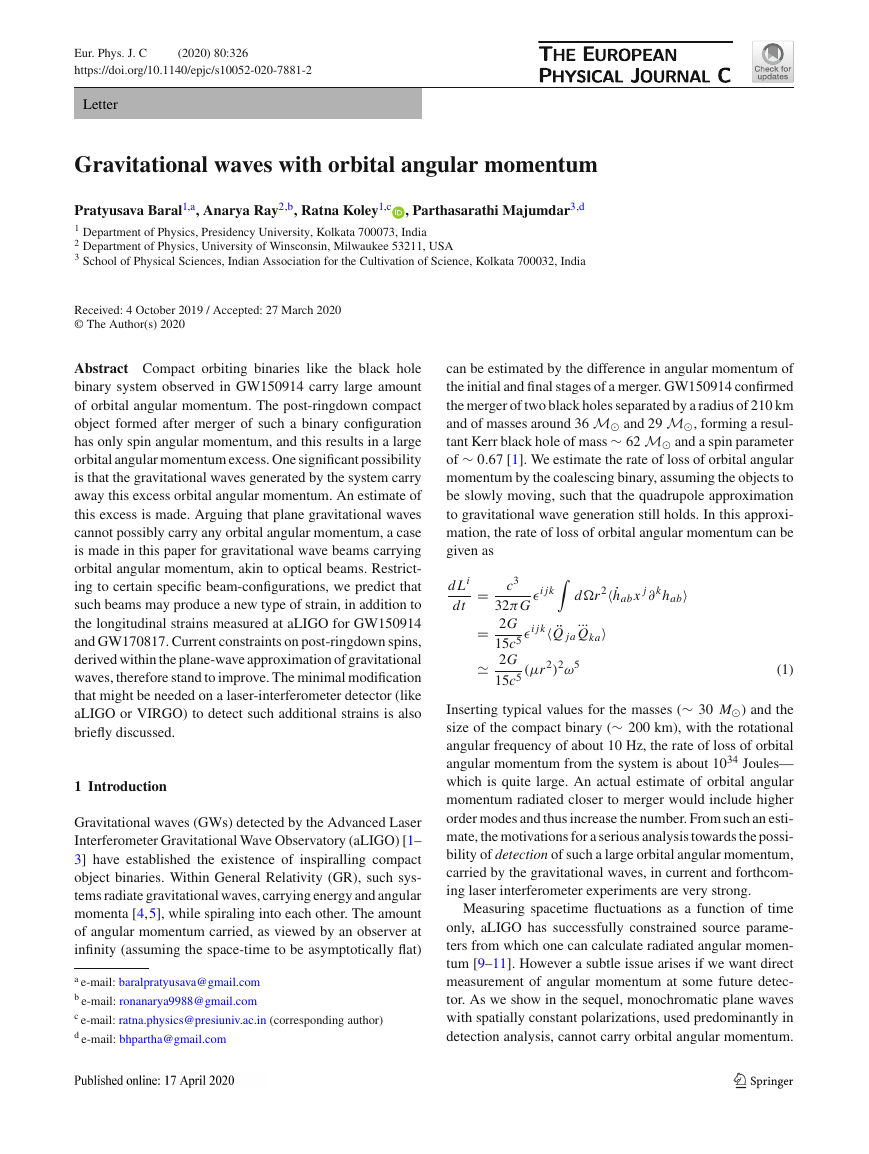
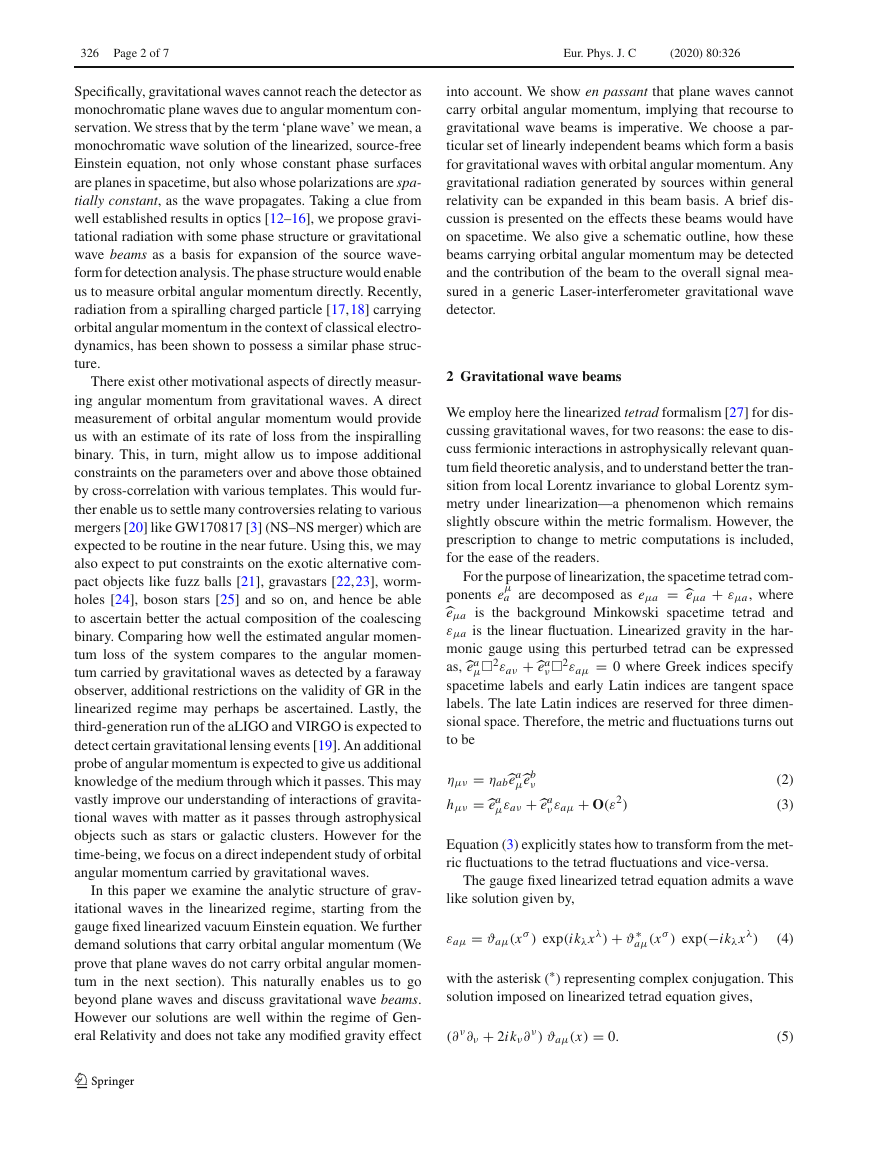
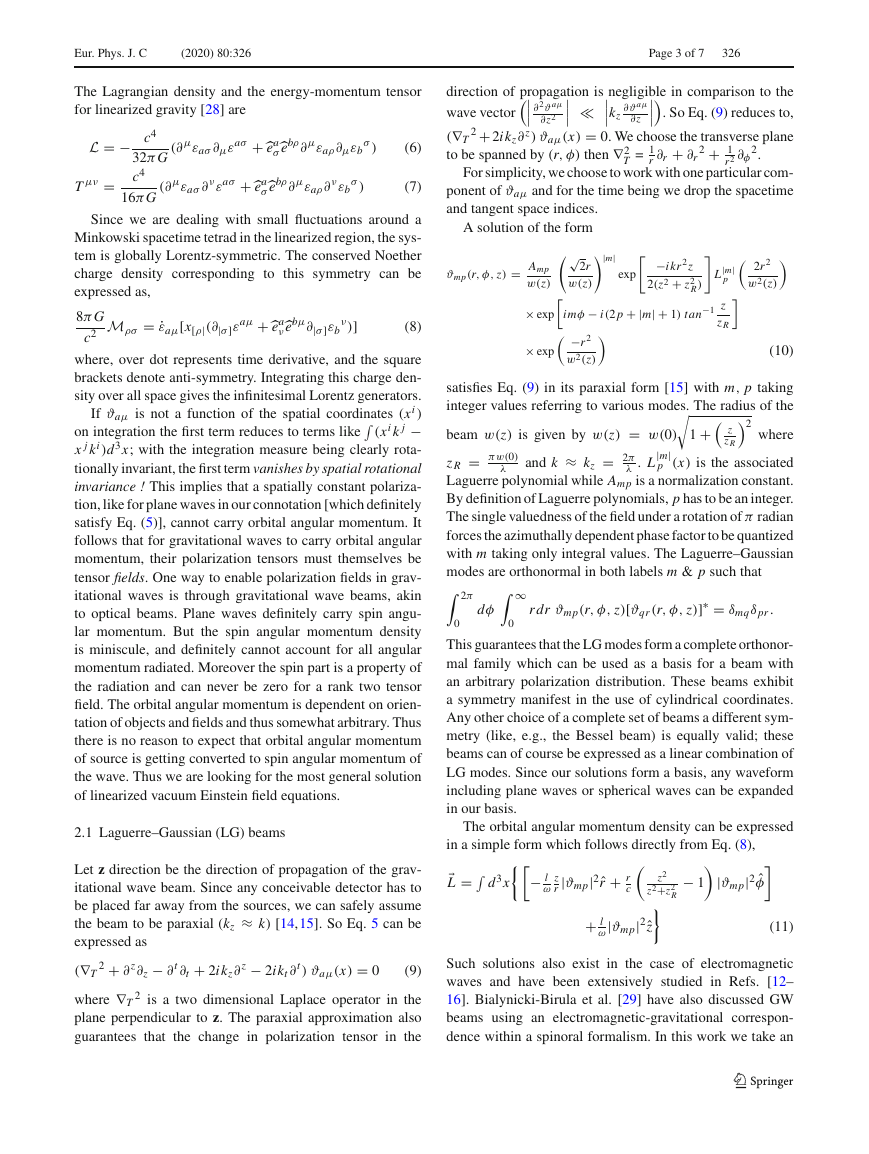
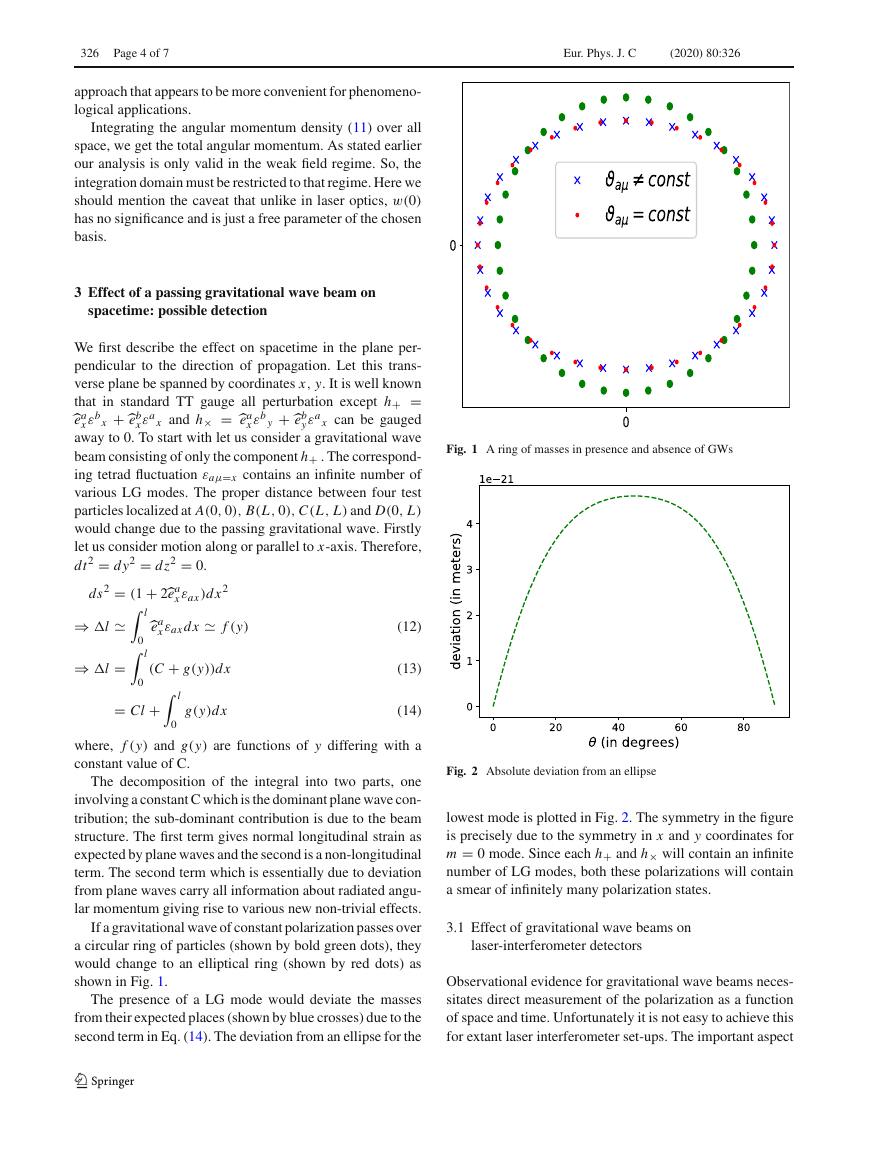
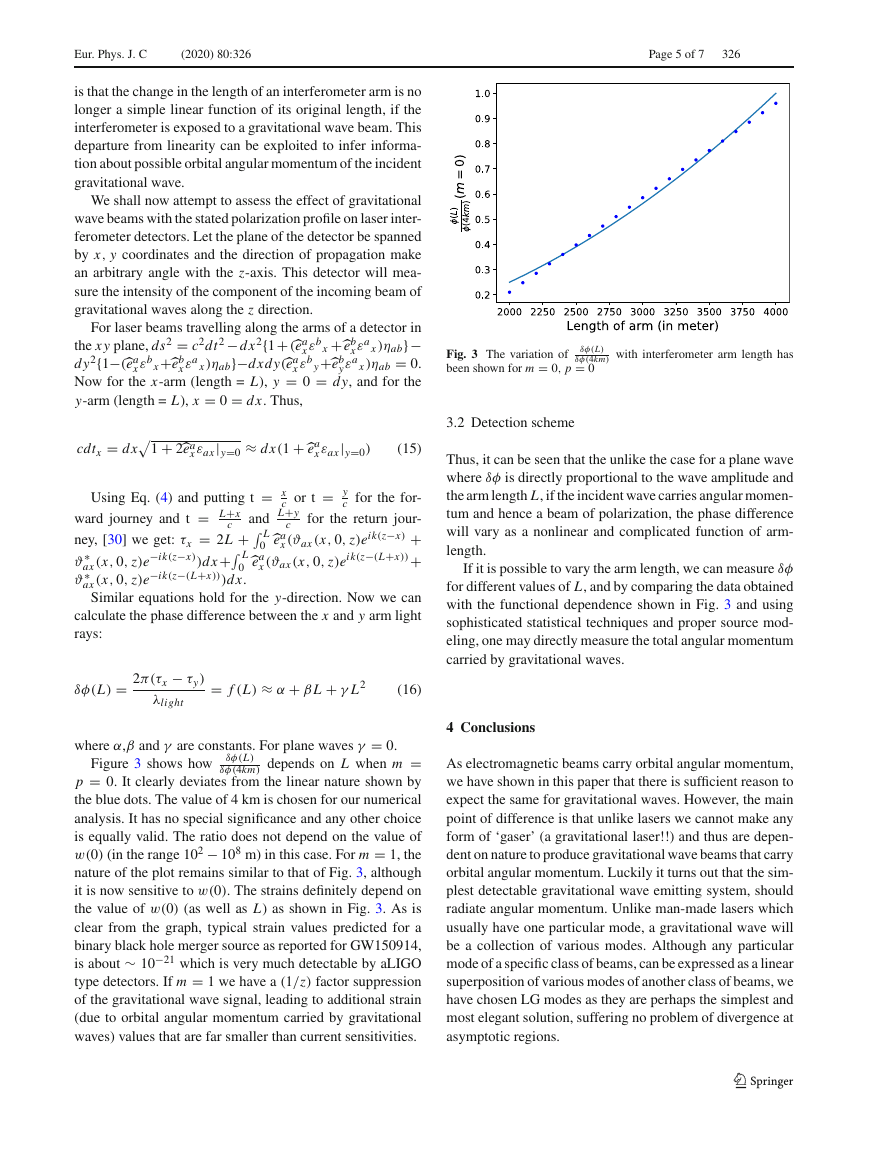
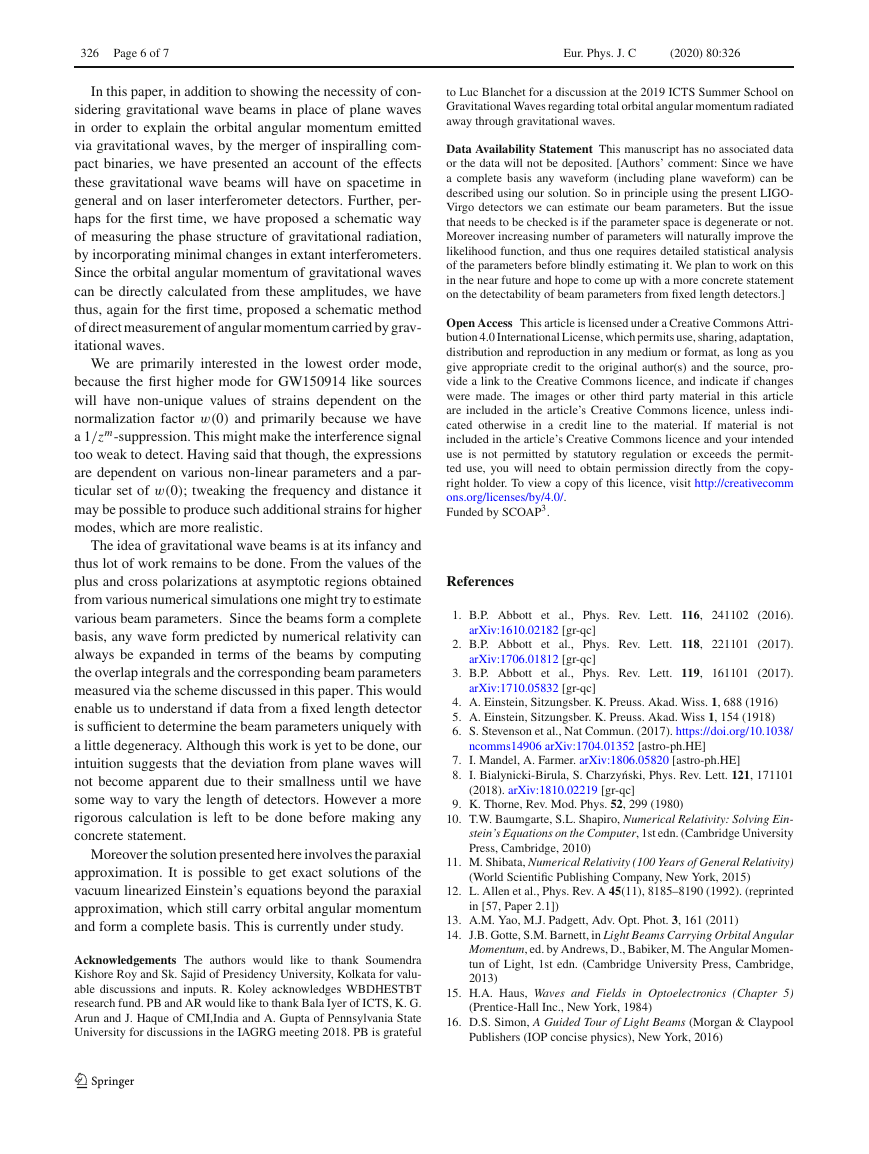
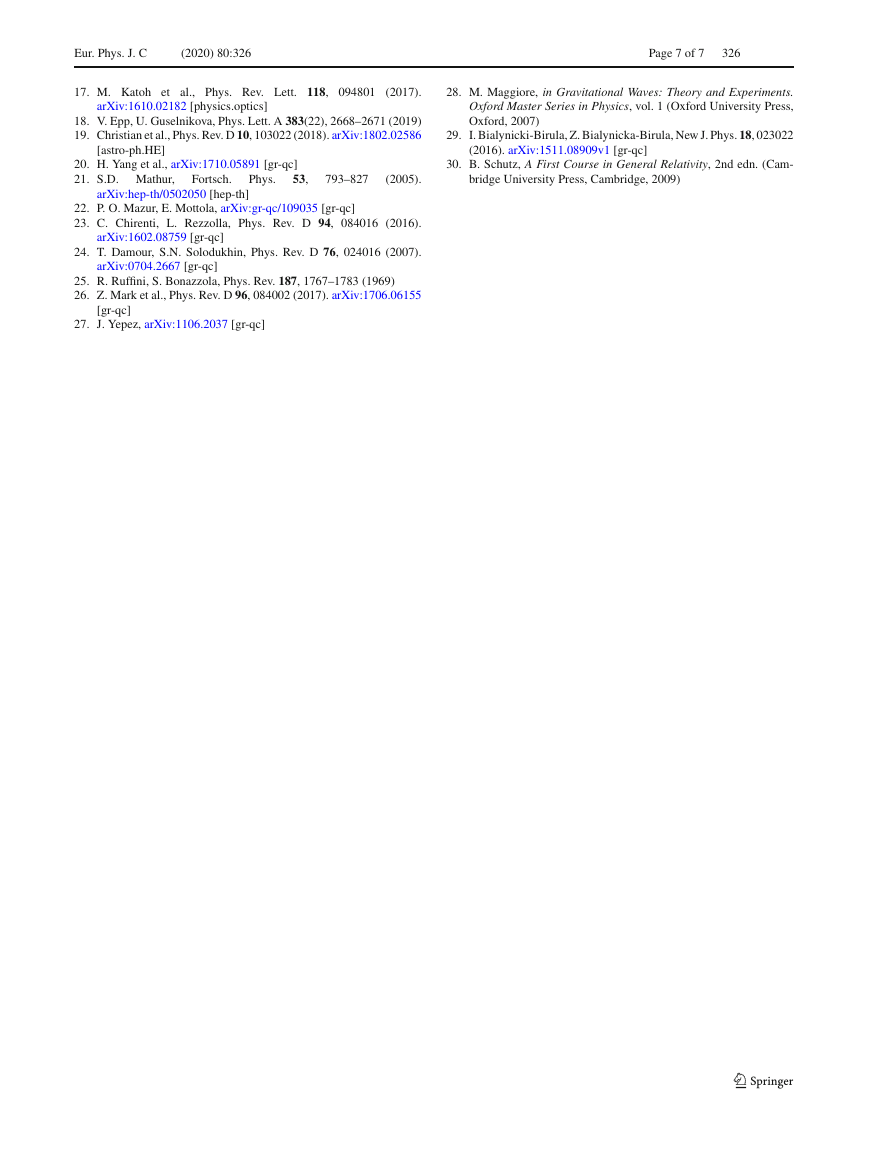







 2023年江西萍乡中考道德与法治真题及答案.doc
2023年江西萍乡中考道德与法治真题及答案.doc 2012年重庆南川中考生物真题及答案.doc
2012年重庆南川中考生物真题及答案.doc 2013年江西师范大学地理学综合及文艺理论基础考研真题.doc
2013年江西师范大学地理学综合及文艺理论基础考研真题.doc 2020年四川甘孜小升初语文真题及答案I卷.doc
2020年四川甘孜小升初语文真题及答案I卷.doc 2020年注册岩土工程师专业基础考试真题及答案.doc
2020年注册岩土工程师专业基础考试真题及答案.doc 2023-2024学年福建省厦门市九年级上学期数学月考试题及答案.doc
2023-2024学年福建省厦门市九年级上学期数学月考试题及答案.doc 2021-2022学年辽宁省沈阳市大东区九年级上学期语文期末试题及答案.doc
2021-2022学年辽宁省沈阳市大东区九年级上学期语文期末试题及答案.doc 2022-2023学年北京东城区初三第一学期物理期末试卷及答案.doc
2022-2023学年北京东城区初三第一学期物理期末试卷及答案.doc 2018上半年江西教师资格初中地理学科知识与教学能力真题及答案.doc
2018上半年江西教师资格初中地理学科知识与教学能力真题及答案.doc 2012年河北国家公务员申论考试真题及答案-省级.doc
2012年河北国家公务员申论考试真题及答案-省级.doc 2020-2021学年江苏省扬州市江都区邵樊片九年级上学期数学第一次质量检测试题及答案.doc
2020-2021学年江苏省扬州市江都区邵樊片九年级上学期数学第一次质量检测试题及答案.doc 2022下半年黑龙江教师资格证中学综合素质真题及答案.doc
2022下半年黑龙江教师资格证中学综合素质真题及答案.doc